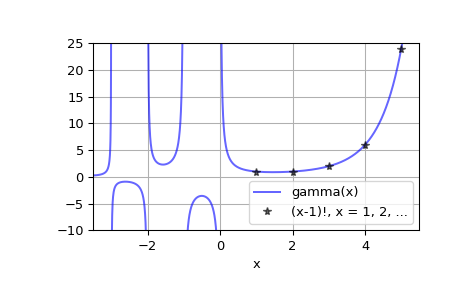scipy.special.gamma¶
- scipy.special.gamma(z) = <ufunc 'gamma'>¶
伽马函数。
伽马函数定义为
\[\Gamma(Z)=\int_0^\inty t^{z-1}e^{-t}dt\]为 \(\Re(z) > 0\) 并通过解析延拓将其推广到复平面的睡觉。看见 [dlmf] 了解更多详细信息。
- 参数
- zarray_like
实值或复值变元
- 退货
- 标量或ndarray
伽马函数的值
注意事项
伽马函数通常被称为广义阶乘,因为 \(\Gamma(n + 1) = n!\) 对于自然数 \(n\) 。更一般地,它满足递推关系 \(\Gamma(z + 1) = z \cdot \Gamma(z)\) 对于复杂的 \(z\) ,这结合了一个事实,那就是 \(\Gamma(1) = 1\) ,隐含着上面的身份 \(z = n\) 。
参考文献
- dlmf
美国国家标准与技术研究院数学函数数字类库https://dlmf.nist.gov/5.2#E1
示例
>>> from scipy.special import gamma, factorial
>>> gamma([0, 0.5, 1, 5]) array([ inf, 1.77245385, 1. , 24. ])
>>> z = 2.5 + 1j >>> gamma(z) (0.77476210455108352+0.70763120437959293j) >>> gamma(z+1), z*gamma(z) # Recurrence property ((1.2292740569981171+2.5438401155000685j), (1.2292740569981158+2.5438401155000658j))
>>> gamma(0.5)**2 # gamma(0.5) = sqrt(pi) 3.1415926535897927
绘制实数x的Gamma(X)图
>>> x = np.linspace(-3.5, 5.5, 2251) >>> y = gamma(x)
>>> import matplotlib.pyplot as plt >>> plt.plot(x, y, 'b', alpha=0.6, label='gamma(x)') >>> k = np.arange(1, 7) >>> plt.plot(k, factorial(k-1), 'k*', alpha=0.6, ... label='(x-1)!, x = 1, 2, ...') >>> plt.xlim(-3.5, 5.5) >>> plt.ylim(-10, 25) >>> plt.grid() >>> plt.xlabel('x') >>> plt.legend(loc='lower right') >>> plt.show()
